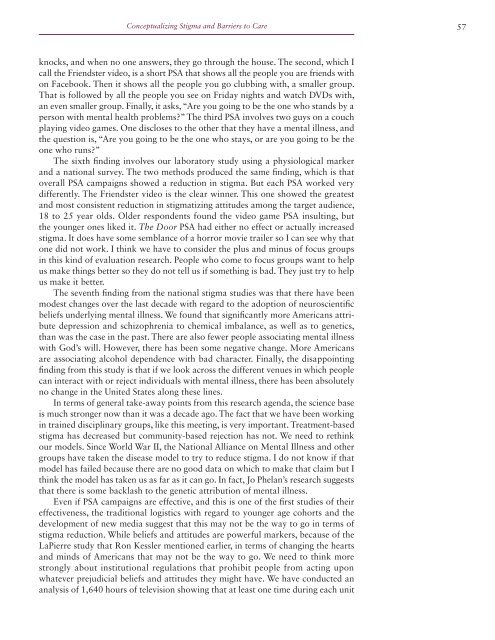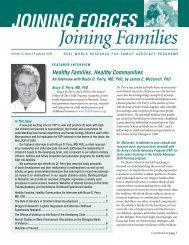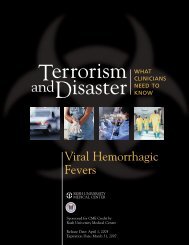stigma and barriers to care - Uniformed Services University of the ...
stigma and barriers to care - Uniformed Services University of the ...
stigma and barriers to care - Uniformed Services University of the ...
Create successful ePaper yourself
Turn your PDF publications into a flip-book with our unique Google optimized e-Paper software.
Conceptualizing Stigma <strong>and</strong> Barriers <strong>to</strong> Care 57<br />
knocks, <strong>and</strong> when no one answers, <strong>the</strong>y go through <strong>the</strong> house. The second, which I<br />
call <strong>the</strong> Friendster video, is a short PSA that shows all <strong>the</strong> people you are friends with<br />
on Facebook. Then it shows all <strong>the</strong> people you go clubbing with, a smaller group.<br />
That is followed by all <strong>the</strong> people you see on Friday nights <strong>and</strong> watch DVDs with,<br />
an even smaller group. Finally, it asks, “Are you going <strong>to</strong> be <strong>the</strong> one who st<strong>and</strong>s by a<br />
person with mental health problems” The third PSA involves two guys on a couch<br />
playing video games. One discloses <strong>to</strong> <strong>the</strong> o<strong>the</strong>r that <strong>the</strong>y have a mental illness, <strong>and</strong><br />
<strong>the</strong> question is, “Are you going <strong>to</strong> be <strong>the</strong> one who stays, or are you going <strong>to</strong> be <strong>the</strong><br />
one who runs”<br />
The sixth finding involves our labora<strong>to</strong>ry study using a physiological marker<br />
<strong>and</strong> a national survey. The two methods produced <strong>the</strong> same finding, which is that<br />
overall PSA campaigns showed a reduction in <strong>stigma</strong>. But each PSA worked very<br />
differently. The Friendster video is <strong>the</strong> clear winner. This one showed <strong>the</strong> greatest<br />
<strong>and</strong> most consistent reduction in <strong>stigma</strong>tizing attitudes among <strong>the</strong> target audience,<br />
18 <strong>to</strong> 25 year olds. Older respondents found <strong>the</strong> video game PSA insulting, but<br />
<strong>the</strong> younger ones liked it. The Door PSA had ei<strong>the</strong>r no effect or actually increased<br />
<strong>stigma</strong>. It does have some semblance <strong>of</strong> a horror movie trailer so I can see why that<br />
one did not work. I think we have <strong>to</strong> consider <strong>the</strong> plus <strong>and</strong> minus <strong>of</strong> focus groups<br />
in this kind <strong>of</strong> evaluation research. People who come <strong>to</strong> focus groups want <strong>to</strong> help<br />
us make things better so <strong>the</strong>y do not tell us if something is bad. They just try <strong>to</strong> help<br />
us make it better.<br />
The seventh finding from <strong>the</strong> national <strong>stigma</strong> studies was that <strong>the</strong>re have been<br />
modest changes over <strong>the</strong> last decade with regard <strong>to</strong> <strong>the</strong> adoption <strong>of</strong> neuroscientific<br />
beliefs underlying mental illness. We found that significantly more Americans attribute<br />
depression <strong>and</strong> schizophrenia <strong>to</strong> chemical imbalance, as well as <strong>to</strong> genetics,<br />
than was <strong>the</strong> case in <strong>the</strong> past. There are also fewer people associating mental illness<br />
with God’s will. However, <strong>the</strong>re has been some negative change. More Americans<br />
are associating alcohol dependence with bad character. Finally, <strong>the</strong> disappointing<br />
finding from this study is that if we look across <strong>the</strong> different venues in which people<br />
can interact with or reject individuals with mental illness, <strong>the</strong>re has been absolutely<br />
no change in <strong>the</strong> United States along <strong>the</strong>se lines.<br />
In terms <strong>of</strong> general take-away points from this research agenda, <strong>the</strong> science base<br />
is much stronger now than it was a decade ago. The fact that we have been working<br />
in trained disciplinary groups, like this meeting, is very important. Treatment-based<br />
<strong>stigma</strong> has decreased but community-based rejection has not. We need <strong>to</strong> rethink<br />
our models. Since World War II, <strong>the</strong> National Alliance on Mental Illness <strong>and</strong> o<strong>the</strong>r<br />
groups have taken <strong>the</strong> disease model <strong>to</strong> try <strong>to</strong> reduce <strong>stigma</strong>. I do not know if that<br />
model has failed because <strong>the</strong>re are no good data on which <strong>to</strong> make that claim but I<br />
think <strong>the</strong> model has taken us as far as it can go. In fact, Jo Phelan’s research suggests<br />
that <strong>the</strong>re is some backlash <strong>to</strong> <strong>the</strong> genetic attribution <strong>of</strong> mental illness.<br />
Even if PSA campaigns are effective, <strong>and</strong> this is one <strong>of</strong> <strong>the</strong> first studies <strong>of</strong> <strong>the</strong>ir<br />
effectiveness, <strong>the</strong> traditional logistics with regard <strong>to</strong> younger age cohorts <strong>and</strong> <strong>the</strong><br />
development <strong>of</strong> new media suggest that this may not be <strong>the</strong> way <strong>to</strong> go in terms <strong>of</strong><br />
<strong>stigma</strong> reduction. While beliefs <strong>and</strong> attitudes are powerful markers, because <strong>of</strong> <strong>the</strong><br />
LaPierre study that Ron Kessler mentioned earlier, in terms <strong>of</strong> changing <strong>the</strong> hearts<br />
<strong>and</strong> minds <strong>of</strong> Americans that may not be <strong>the</strong> way <strong>to</strong> go. We need <strong>to</strong> think more<br />
strongly about institutional regulations that prohibit people from acting upon<br />
whatever prejudicial beliefs <strong>and</strong> attitudes <strong>the</strong>y might have. We have conducted an<br />
analysis <strong>of</strong> 1,640 hours <strong>of</strong> television showing that at least one time during each unit




